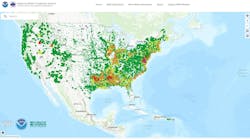Returning home from StormCon 2014, our approach into Austin was over the urbanized area. From horizon to horizon, we saw a spaghetti bowl of roads connecting business centers, shops, homes, and parking lots. The ever-expanding sprawl induced an image of a watershed sickness, a permanent alteration to the natural environment that could not be healed. My eyes drilled down to the street level, and I imagined storm drain systems rapidly delivering storm surges of energized flow and pollutants directly to creeks, aquifers, and the Colorado River.
I have to admit, I felt a sense of doom, even after practicing stormwater engineering and management for over 32 years and having just heard the latest research and innovations at StormCon. I wondered if we make a measurable difference in improving water quality in the face of such urbanization?
In Austin, thousands of stormwater basins lay waiting for the next storm, yet many creeks are fouled by bacteria and pollutants, and the natural habitat has been lost due to excessive erosion from hydrologic change while others in the region are in the TMDL evaluation and watershed protection planning process. To further challenge effective stormwater management, many jurisdictions don’t have water-quality requirements, leading to a patchwork of regulations. Engineering skills vary, and games can be played with hydrologic parameters to reduce stormwater basin costs and lead to poor-performing facilities.
Our flight path into Austin was over the Highland Lakes, the primary water supply for 1.2 million people. Lake levels continue to hover around 35% full as the near-decade-long drought continues. Driving through Austin at sunset, even in a declared drought with water conservation measures in effect, I saw irrigation systems hosing down lawns and landscapes. Construction continues throughout Austin, which is recognized as one of the fastest growing cities in the US. Each new development increases the daily water demands on the Lakes and aquifers, and even though the builders know the greatest threat to their business is the lack of water, the development progresses at a breakneck pace.
Returning home from StormCon 2014, our approach into Austin was over the urbanized area. From horizon to horizon, we saw a spaghetti bowl of roads connecting business centers, shops, homes, and parking lots. The ever-expanding sprawl induced an image of a watershed sickness, a permanent alteration to the natural environment that could not be healed. My eyes drilled down to the street level, and I imagined storm drain systems rapidly delivering storm surges of energized flow and pollutants directly to creeks, aquifers, and the Colorado River. I have to admit, I felt a sense of doom, even after practicing stormwater engineering and management for over 32 years and having just heard the latest research and innovations at StormCon. I wondered if we make a measurable difference in improving water quality in the face of such urbanization? In Austin, thousands of stormwater basins lay waiting for the next storm, yet many creeks are fouled by bacteria and pollutants, and the natural habitat has been lost due to excessive erosion from hydrologic change while others in the region are in the TMDL evaluation and watershed protection planning process. To further challenge effective stormwater management, many jurisdictions don't have water-quality requirements, leading to a patchwork of regulations. Engineering skills vary, and games can be played with hydrologic parameters to reduce stormwater basin costs and lead to poor-performing facilities. Our flight path into Austin was over the Highland Lakes, the primary water supply for 1.2 million people. Lake levels continue to hover around 35% full as the near-decade-long drought continues. Driving through Austin at sunset, even in a declared drought with water conservation measures in effect, I saw irrigation systems hosing down lawns and landscapes. Construction continues throughout Austin, which is recognized as one of the fastest growing cities in the US. Each new development increases the daily water demands on the Lakes and aquifers, and even though the builders know the greatest threat to their business is the lack of water, the development progresses at a breakneck pace. [text_ad] Many say, let the state build new water resources to secure our economic future and manage droughts. To that end, Texas recently enacted a $2 billion water supply development and conservation enhancement fund. However, it is literally a drop in the bucket, as the State Water Plan indicates that more than $50 billion in projects are necessary to meet the rapidly growing demands by 2050. It can take 10 years or more to build new projects, and most new supplies (reservoirs, aquifer pumping, pipeline transfer, etc.) will rely on stormwater runoff to fill or recharge the resource. While pulling into my driveway after crossing the dry creek bed, I thought we need to shift our stormwater management target to increase water supply quantity first and include the benefits of water-quality protection rather than our current approach. Especially in the arid Southwest, should the first priority in stormwater management be to conserve and expand water supplies? By designing stormwater management systems for water supply enhancement, we can reduce water demands every day by deriving benefits from each house and business. This can yield a daily return on the stormwater management investment, rather than one based on an infrequent storm event rate of return. Plenty of water can be saved as evidenced by the State Water Plan; some communities use more than 300 gallons per person per day, with a majority for outdoor irrigation. If we implement measures that infiltrate runoff and store water, new development demands can be decreased by 70% or more, netting valuable supply increases. This can be accomplished through conservation landscaping, shallow berms, native plants, improved soils, rainwater harvesting, and runoff storage for non-potable uses. This approach can reduce water-quality and detention costs and yield drainage utility fee credits as less and cleaner runoff drains to the public system. One agency in the Austin area, the Lower Colorado River Authority, offers these water demand reduction BMPs that receive stormwater quality credits through its Highland Lakes Watershed Ordinance program. The water conservation options and incentives have led to more than 80% of all permitted projects taking the water savings development path. Designing for water supply can significantly shrink projected water demands, delaying or avoiding costly water projects, and can benefit rate payers, all through the stormwater management program. For example, a recent paper identified that using these designs in the growing Austin region can save nearly 40,000 acre-feet per year when applied to new homes over the next 25 years. This demand reduction is comparable to half the amount of water being made available by a new water supply reservoir that is under construction and will cost about $250 million. We need to think about the public as our customers, much like a water and wastewater utility does, and by doing so link water utility and stormwater programs to provide broader water resource services and reduce monthly water bills. I am not suggesting that we ignore water quality and floodplain management; rather, that water supply expansion be the priority design requirement in drought prone regions. Designing for water supply protection will lead to wider implementation of LID as the micro-scale approach brings stormwater management to the individual site level and yields direct water returns to the owner. If stormwater program operators can get comfortable with privately maintained diverse and redundant measures, their program costs can be reduced while achieving higher performance than end-of-pipe systems. What better place to have this conversation than StormCon 2015 in Austin, in a state plagued by drought with supplies barely above critical stages even after experiencing recent 100-year localized storms. By designing for water supply, we can illuminate the stormwater regulatory program benefits in terms of water rates, program cost reduction, watershed protection, and larger environmental benefits such as flowing springs and rivers and improved lake levels that can help meet future generations' water needs.Many say, let the state build new water resources to secure our economic future and manage droughts. To that end, Texas recently enacted a $2 billion water supply development and conservation enhancement fund. However, it is literally a drop in the bucket, as the State Water Plan indicates that more than $50 billion in projects are necessary to meet the rapidly growing demands by 2050. It can take 10 years or more to build new projects, and most new supplies (reservoirs, aquifer pumping, pipeline transfer, etc.) will rely on stormwater runoff to fill or recharge the resource.
While pulling into my driveway after crossing the dry creek bed, I thought we need to shift our stormwater management target to increase water supply quantity first and include the benefits of water-quality protection rather than our current approach. Especially in the arid Southwest, should the first priority in stormwater management be to conserve and expand water supplies?
By designing stormwater management systems for water supply enhancement, we can reduce water demands every day by deriving benefits from each house and business. This can yield a daily return on the stormwater management investment, rather than one based on an infrequent storm event rate of return. Plenty of water can be saved as evidenced by the State Water Plan; some communities use more than 300 gallons per person per day, with a majority for outdoor irrigation. If we implement measures that infiltrate runoff and store water, new development demands can be decreased by 70% or more, netting valuable supply increases.
This can be accomplished through conservation landscaping, shallow berms, native plants, improved soils, rainwater harvesting, and runoff storage for non-potable uses. This approach can reduce water-quality and detention costs and yield drainage utility fee credits as less and cleaner runoff drains to the public system. One agency in the Austin area, the Lower Colorado River Authority, offers these water demand reduction BMPs that receive stormwater quality credits through its Highland Lakes Watershed Ordinance program. The water conservation options and incentives have led to more than 80% of all permitted projects taking the water savings development path.
Designing for water supply can significantly shrink projected water demands, delaying or avoiding costly water projects, and can benefit rate payers, all through the stormwater management program. For example, a recent paper identified that using these designs in the growing Austin region can save nearly 40,000 acre-feet per year when applied to new homes over the next 25 years. This demand reduction is comparable to half the amount of water being made available by a new water supply reservoir that is under construction and will cost about $250 million. We need to think about the public as our customers, much like a water and wastewater utility does, and by doing so link water utility and stormwater programs to provide broader water resource services and reduce monthly water bills.
I am not suggesting that we ignore water quality and floodplain management; rather, that water supply expansion be the priority design requirement in drought prone regions. Designing for water supply protection will lead to wider implementation of LID as the micro-scale approach brings stormwater management to the individual site level and yields direct water returns to the owner. If stormwater program operators can get comfortable with privately maintained diverse and redundant measures, their program costs can be reduced while achieving higher performance than end-of-pipe systems.
What better place to have this conversation than StormCon 2015 in Austin, in a state plagued by drought with supplies barely above critical stages even after experiencing recent 100-year localized storms. By designing for water supply, we can illuminate the stormwater regulatory program benefits in terms of water rates, program cost reduction, watershed protection, and larger environmental benefits such as flowing springs and rivers and improved lake levels that can help meet future generations’ water needs.





